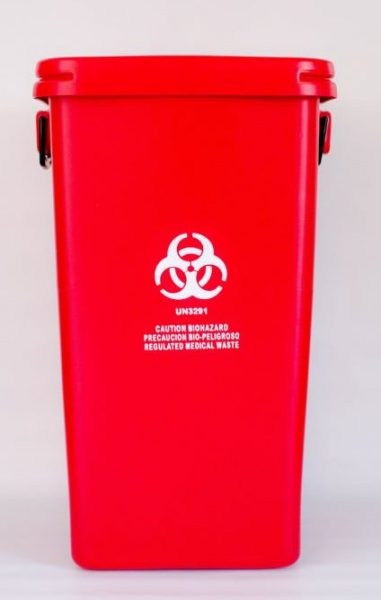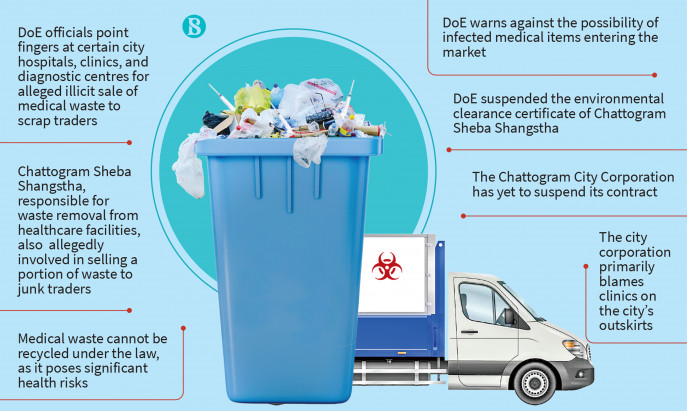Safeguarding Health: Professional Medical Waste Removal Services for a Clean Environment
Wiki Article
Reliable and Eco Friendly Medical Garbage Disposal Solutions
In the ever-evolving area of healthcare, the problem of medical waste disposal stays a subject of critical relevance. As health centers, centers, and various other healthcare facilities make every effort to provide high quality patient care, they need to additionally deal with the difficulty of efficiently and properly disposing of their waste.Waste Partition Practices
Effective waste segregation methods are important to guarantee the risk-free and correct disposal of medical waste. Clinical waste, that includes materials contaminated with potentially contagious compounds, should be taken care of in such a way that lessens the threat of harm to both public health and wellness and the setting. Proper waste partition plays an important duty in accomplishing this goal.Waste segregation involves the separation of different kinds of waste based on their qualities and potential risks. This process ensures that each sort of waste is dealt with and gotten rid of properly (medical waste disposal services with WasteX). It starts at the point of generation, where medical care facilities need to have assigned containers and containers for different waste categories, such as sharps, infectious waste, pharmaceutical waste, and non-hazardous waste
By segregating clinical waste at the source, health care carriers can avoid cross-contamination and minimize the danger of exposure to contagious agents. This method also helps with the recycling and recovery of specific products. For example, setting apart and recycling tidy plastics and glass minimizes the demand for basic materials and reduces the ecological impact of clinical waste disposal.

Autoclaving and Sterilization Techniques
In order to guarantee the correct and risk-free disposal of medical waste adhering to effective waste partition practices, medical care facilities have to use autoclaving and sanitation techniques. Autoclaving is a commonly made use of method that utilizes high-pressure heavy steam to decontaminate medical waste.An additional frequently made use of sanitation method is chemical sanitation. This includes treating the waste with chemicals such as ethylene oxide or hydrogen peroxide, which kill microorganisms by interrupting their cellular framework. Chemical sterilization is typically made use of for heat-sensitive things or products that can not stand up to the high temperature levels of autoclaving. Nevertheless, it is essential to keep in mind that chemical sterilization requires correct handling and disposal of the chemicals utilized, as they can be hazardous to human health and wellness and the setting if not taken care of appropriately.
On-Site Waste Treatment Equipments
Healthcare facilities have carried out on-site waste therapy systems to address the disposal of clinical waste in a reliable and safe fashion. These systems give a convenient and affordable remedy for handling medical waste created within the center. On-site waste therapy systems utilize numerous technologies to deal with and get rid of of clinical waste on-site, minimizing the demand for transportation to off-site facilities.One commonly used on-site waste therapy system is the microwave modern technology. An additional system is the chemical disinfection innovation, which includes dealing with medical waste with chemicals to eliminate pathogens and reduce its unsafe nature. medical waste disposal services with WasteX.
They get rid of the risk of clinical waste being mishandled during transport, lowering the capacity for contamination and direct exposure to damaging substances. On-site therapy systems decrease the overall ecological effect of medical waste by decreasing transportation and the requirement for landfill room.
Recycling and Repurposing Initiatives
As health care facilities pursue lasting waste monitoring techniques, they are significantly checking out recycling and repurposing efforts as a way of reducing the ecological influence of clinical waste. Recycling and repurposing campaigns entail finding ingenious means to reuse or transform medical waste right into brand-new items or materials. This not just aids to minimize the volume of waste that winds up in land fills or burners yet additionally decreases the consumption of raw materials and energy required for making new items.
One example of recycling in the health care industry is the reprocessing of single-use medical devices. These gadgets, such as medical instruments or catheters, are commonly discarded after a single use. Nonetheless, advancements in innovation and stringent sterilization processes have actually made it feasible to securely clean, decontaminate, and recycle these tools multiple times. This not only lowers the quantity of waste produced yet likewise saves medical care facilities significant costs linked with acquiring brand-new tools.
One more recycling effort includes the recycling of plastic containers, such as medication bottles or syringe coverings. These containers can be accumulated, sorted, and sent out to recycling facilities where they are refined, thawed down, and transformed into new plastic products. This assists to save resources and lower the demand for virgin plastic manufacturing.
In enhancement to reusing, repurposing efforts include discovering alternative usages for medical waste. Shredded paper waste from medical records or packaging products can be repurposed as bedding material for pets or as insulation material. Likewise, organic waste such as food scraps from health care centers can be composted and made use of as plant food in yards or farming areas.

Renewable Resource Solutions
One effective approach to reducing the environmental impact of healthcare operations entails implementing renewable resource options. Health care centers, such as centers and medical facilities, consume significant quantities of power for numerous functions, including lighting, home heating, air conditioning, and operating clinical tools. By transitioning to renewable resource sources, these centers can dramatically minimize their carbon footprint and add to a much more lasting future.

Carrying out renewable resource remedies in medical care centers not only reduces greenhouse gas exhausts yet additionally provides lasting cost financial savings. While the preliminary financial investment in renewable resource facilities may be higher, the lasting functional prices of eco-friendly power systems are considerably lower contrasted to traditional fossil fuel-based power sources. Additionally, renewable resource systems are reputable and can offer a steady and uninterrupted power supply, guaranteeing constant healthcare solutions also throughout power outages or emergency situations.
Final Thought
In conclusion, carrying out efficient and eco-friendly medical garbage disposal solutions is important for preserving a lasting healthcare system. By embracing waste segregation techniques, autoclaving and sterilization methods, on-site waste treatment systems, reusing and repurposing efforts, and eco-friendly energy solutions, health care centers can considerably decrease their ecological influence. These steps not just shield the environment however additionally promote public wellness and safety. Therefore, it is vital for medical care companies to focus on the implementation of these lasting waste disposal methods.It starts at the factor of generation, where health care facilities ought to have marked bins and containers for various waste categories, such as sharps, contagious waste, pharmaceutical waste, and non-hazardous waste.
In order to make certain the risk-free and correct disposal of clinical waste following effective waste partition practices, medical care facilities need to employ autoclaving and sanitation techniques.Medical care centers have executed on-site waste treatment check these guys out systems to address the disposal of clinical waste in a reliable and risk-free way. On-site waste therapy systems use different technologies to get rid of and treat of clinical waste on-site, lessening the need for transport to off-site centers.
As healthcare facilities make every effort for medical waste disposal services with WasteX sustainable waste management techniques, they are significantly exploring recycling and repurposing efforts as a method of minimizing the environmental effect of medical waste. - medical waste removal
Report this wiki page